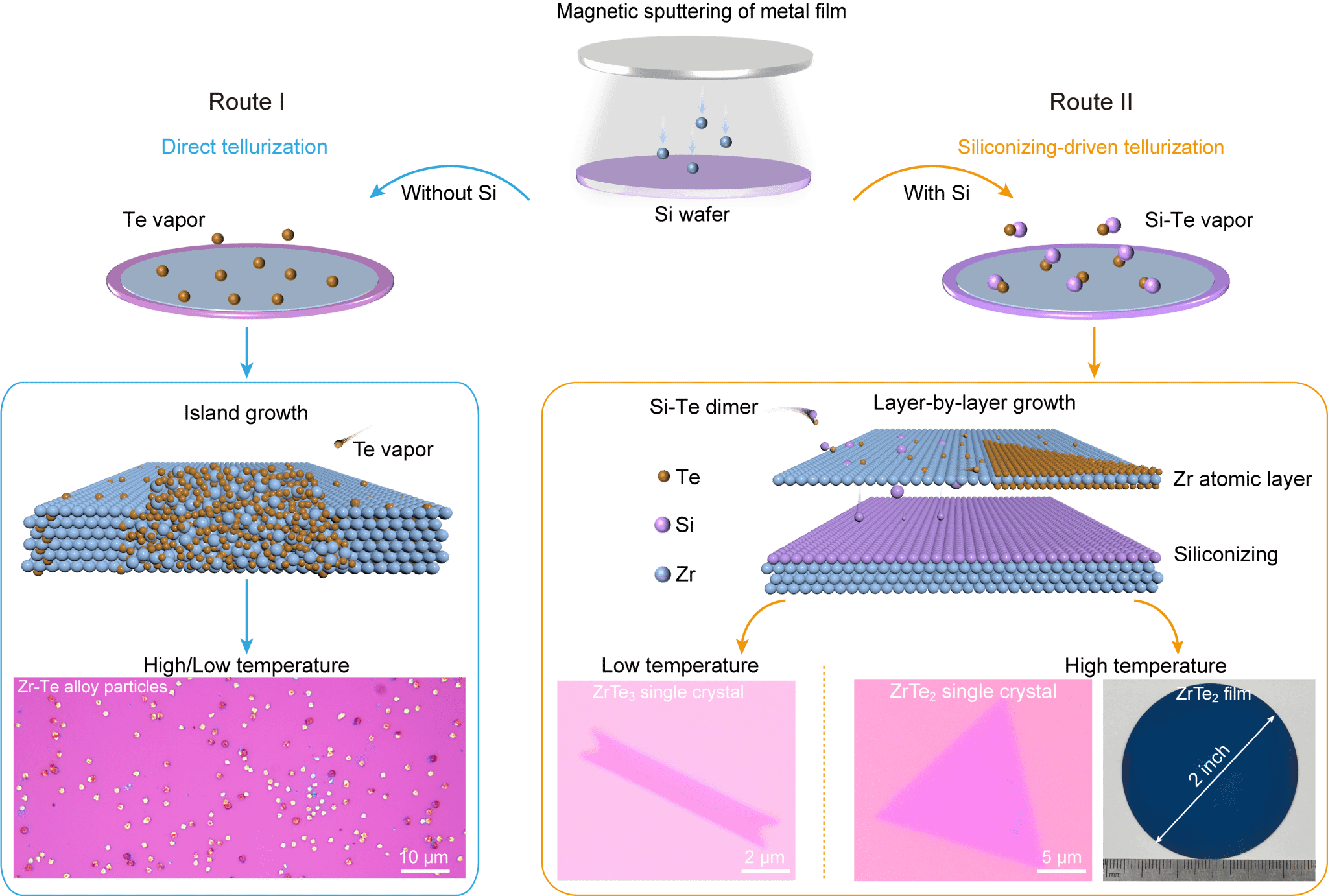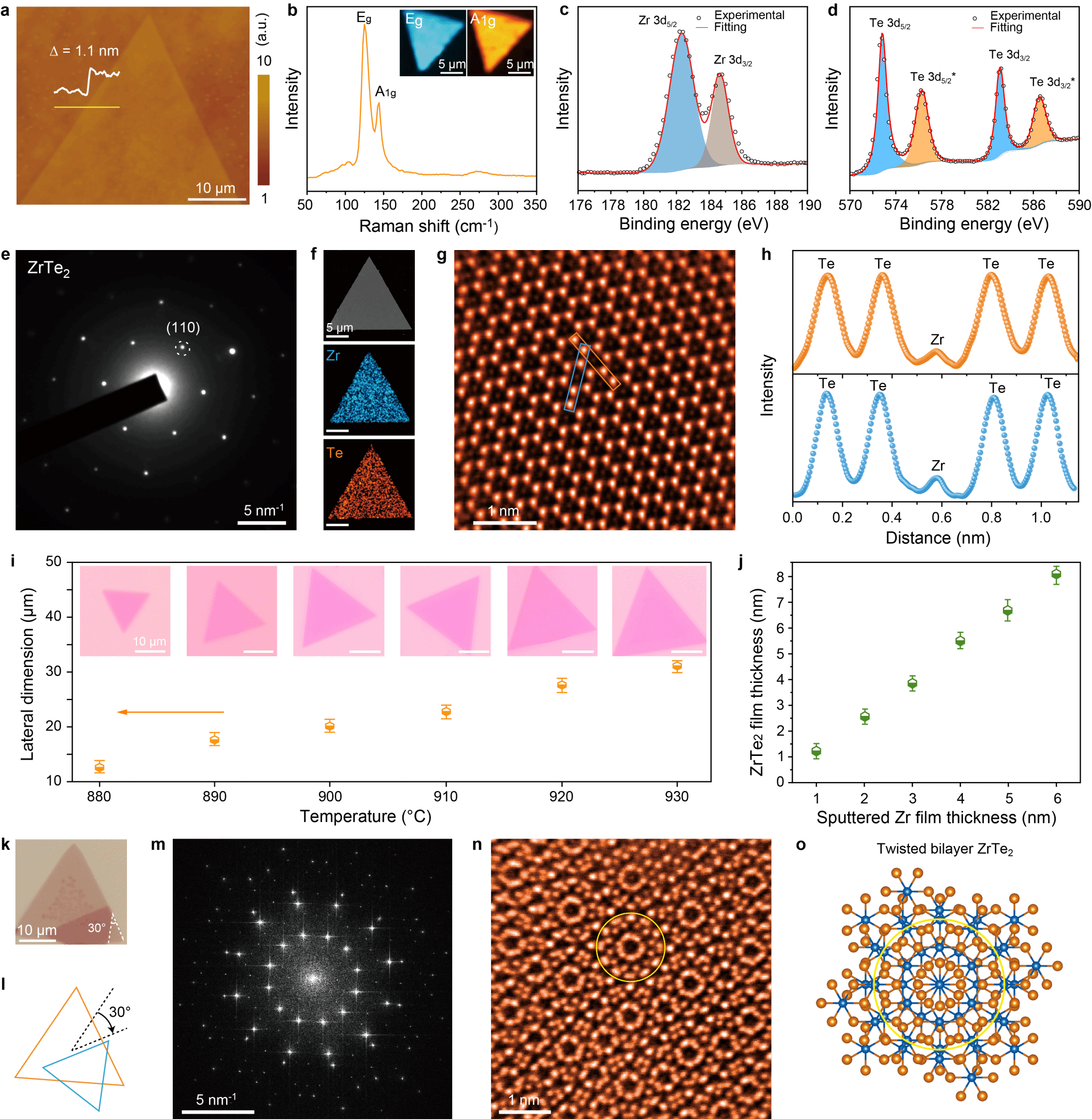On June 3, 2025, a collaborative research team led by Professor Chen Ke from Henan University, along with Professor Mingju Huang (Henan University), Professor Feng Ding (Shenzhen Institute of Advanced Technology, Chinese Academy of Sciences), and Professor Can Liu (Renmin University of China), has made significant breakthroughs in the controlled growth of two-dimensional (2D) transition metal tellurides. Their research achievements, titled "Siliconizing-Driven Layer-by-Layer Growth of Two-Dimensional Tellurides with Controlled Crystallization", were published online in the international top-tier journal 《Advanced Materials》 (DOI: 10.1002/adma.202501451), with Henan University listed as the first corresponding institution.
1. Introduction
In recent years, two-dimensional transition metal tellurides (TMTs) have garnered significant attention due to their unique physical properties. They exhibit fascinating characteristics such as room-temperature ferromagnetism, superconductivity, chiral anomaly effects, and anisotropic negative magnetoresistance, making them highly promising for applications in spintronics, topological quantum devices, and optoelectronics. However, compared to the widely prepared transition metal sulfides and selenides, the challenges of weak bonding energy between tellurium (Te) and transition metals, as well as difficult phase control during high-temperature synthesis, have severely limited the controllable preparation of high-quality TMTs. Additionally, traditional methods relying on high Te vapor flux often lead to complex phase compositions, uneven crystallinity, and difficulty in achieving large-scale uniform growth.
2. Achievement Summary
In this study, a Si-driven layer-by-layer growth strategy was proposed to successfully synthesize two-dimensional (2D) ZrTe2 and ZrTe3 crystals with high crystallinity and controllable thickness. By introducing Si-Te dimers, the partial pressure of Te₂ in the reaction system was significantly reduced, and the atomic-scale precise controlled tellurization of Zr films was achieved through the permeation and isolation effects of Si atoms. The ZrTe2 crystals synthesized based on this strategy exhibit type-II Weyl semimetal characteristics (negative magnetoresistance effect, with a magnetoresistance of 30% at 2 K and 9 T), while ZrTe3 shows charge density waves (~34 K) and intrinsic superconductivity (~3 K). Theoretical studies indicate that Si atoms can permeate Zr films layer by layer to enable controlled layer-by-layer tellurization.
This work provides a new approach for the precise and controllable synthesis of 2D TMTs, achieves siliconizing-driven controllable growth of 2D zirconium telluride crystals, and offers a novel pathway for the large-scale synthesis of high-quality 2D transition metal tellurides with controlled phase structures. It also lays a material foundation for the innovation of spintronic devices based on 2D topological materials.
3. Graphical Abstract

Figure 1. Schematic for siliconizing-driven growth of 2D zirconium telluride compound crystals. The synthesis of zirconium telluride compound crystals can be achieved by two different reaction routes. The morphologies of the as-synthesized products are observed by optical microscopy. The direct tellurization process of Zr film results in the uncontrolled nucleation and island growth of Zr-Te alloy particles with complex phases (Route I). In sharp contrast, with the assistance of Si, the uniform 2D ZrTe2 and ZrTe3 crystals can be grown at high and low temperatures, respectively (Route II). And a continuous ZrTe2 film on a 2-inch wafer can also be grown on a large scale as observed with an unaided eye.

Figure 2. Controlled synthesis and characterizations of 2D ZrTe2 crystals. a) AFM image of ZrTe2 flake. b) Raman spectrum of ZrTe2. The insets are the Raman intensity maps of the A1g and Eg modes in ZrTe2. c, d) High-resolution XPS spectra of Zr 3d and Te 3d of ZrTe2. e) SAED pattern of ZrTe2 crystals. f) HAADF and corresponding EDS mappings of ZrTe2 crystals. g) Atom-resolved HAADF-STEM image of ZrTe2 crystals. h) Intensity line profiles for the red and blue rectangles marked in g. i) Statistical lateral grain size of ZrTe2 synthesized at different temperatures using a 1-nm Zr film. The insets are the corresponding typical OM images. All scales are 10 μm. j) The ZrTe2 film thickness as a function of sputtered Zr thickness. k-o) Characterizations of 30°-twisted bilayer ZrTe2. (k) Optical image. (l) Schematic twist angle. (m) SAED patterns. (n) Atomic-resolved HAADF-STEM image. (o) Corresponding moiré pattern diagram.

Figure 3. Mechanism of siliconizing-driven layer-by-layer growth of 2D ZrTe2. a) Structures during the growth process of 2D ZrTe2 obtained using first-principles and molecular dynamics methods. Structures during molecular dynamics simulations of the system composed of Si-Te dimers and Zr film at 1000 K for 1 ps (i) and 5 ps (ii). (iii) Structure during molecular dynamics simulations of the system composed of Zr-Te layer and Si passivating Zr film at 300 K for 5 ps. (iv) Optimized configuration of ZrTe2 layer on Si passivated Zr surface. b) Schematic for the growth process of 2D ZrTe2. c) Structures for the movement of a Si atom within the Zr surface and relative energies for the initial state (IS), transition state (TS), and final state (FS) are given. d) Electron localization function for the system consisting of monolayer ZrTe2 and the substrate. Blue, orange and purple spheres indicate Zr, Te and Si atoms, respectively.
Dr. Weitao Liu from Henan University, Dr. Qinghe Wang from Peking University, and Dr. Yuanyuan Zhao from Dalian University of Technology are the co-first authors of the paper. Professor Ke Chen and Professor Mingju Huang from Henan University, Professor Feng Ding from the Shenzhen Institute of Advanced Technology (Chinese Academy of Sciences), and Professor Can Liu from Renmin University of China serve as the co-corresponding authors. Collaborative contributions were also made by Professor Kaihui Liu, Professor Peng Gao, and Researcher Zhaolong Chen from Peking University, Professor Feng Yang from Southern University of Science and Technology, and other scholars. Henan University is listed as the first corresponding institution for this research. The study was supported by projects such as the National Natural Science Foundation of China, the National Ten-Thousand Talent Program, and the Central Plains Talent Program of Henan Province. he paper link is provided below:
https://advanced.onlinelibrary.wiley.com/doi/10.1002/adma.202501451